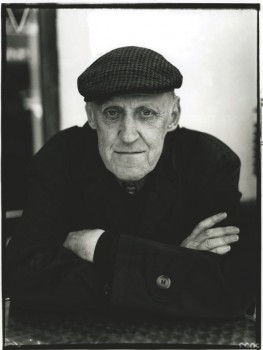Search results for "jarkko/2011/04/matti-suurpaa-parnasso-1951–2011-parnasso-1951–2011"
Saamentutkimus tänään [Sámi research today]
30 June 2011 | Mini reviews, Reviews
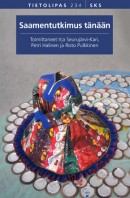 Saamentutkimus tänään
Saamentutkimus tänään
[Sámi research today]
Toimittaneet [Edited by] Irja Seurujärvi-Kari, Petri Halinen & Risto Pulkkinen
Helsinki: Suomalaisen Kirjallisuuden Seura (SKS), 2011. 449 p., ill.
ISBN 978-952-222-220-6
€ 28, paperback
This volume examines the Sámi people, the only indigenous tribe living in the European Union, via writers representing fourteen different fields of research. It is an updated and expanded edition of Johdatus Saamentutkimukseen (‘An introduction to Sámi research’, 1995) and makes use of The Saami. A Cultural Encyclopaedia (SKS, 2005). This book defines what is meant by the terms ‘indigenous tribe’ and ‘Sámi’, as well as describing the Sámi people’s biological and geographical environment, their prehistory and history and a linguistic and genetic outline. It also deals with their spiritual and material culture, from folk beliefs to handicrafts and arts, as well as reindeer herding. The status of the Sámi people is examined with regard to human rights and land ownership rights and compared to the situation of other indigenous tribes. Currently between 70,000 and 82,000 Sámi live in Finland, Sweden, Norway and Russia, with around 10,000 of them in Finland. The Sámi population in Finland has remained constant for the past 15 years, but as many as 60 per cent of them now live outside the traditional Sámi homelands.
Translated by Ruth Urbom
Rooms with views
21 August 2014 | Extracts, Non-fiction
Most of us live in box-shaped houses; the long-prevailing laws of modernist architecture relate to cubes, geometry and masses. Together with an architect, artist Jan-Erik Andersson designed a leaf-shaped house for himself. Could it be both art and architecture? In his new book he takes a look at non-cubical buildings in Finland and beyond, attempting to define what makes ‘wow factor architecture’: good architecture requires freedom from strict aesthetic rules.
Extracts from the chapter entitled ‘Det inre rummet’ (‘The inner room’) in Wow. Åsikter om finländsk arkitektur (‘Wow. Thoughts on Finnish architecture’, Schildts & Söderströms, 2014)
I remember from my childhood in the 1960s how my brother and I each lay in our beds in a little room late in the evening and stared up at the ceiling, onto which the lights from cars outside cast patterns. The patterns were constantly changing, they were like the doors of imagination onto eternity. Along with the hum of the engines they lulled me into a kind of half-stupor.
During the days the floor of the room grew to a town as we threw ourselves into a world of adventures and sped around with Formula 1 cars. Or the waste-paper bin was squeezed into a corner between the bookshelf and the wall, and the room took on the dimensions of a basketball court.
When defining a room it is difficult to distinguish between the outer, physical room, and the inner room formed by your consciousness. More…
Språk och politisk mobilisering. Finlandssvenskar i publikdemokrati [Language and political mobilisation. Finland-Swedes in public democracy]
10 June 2011 | Mini reviews, Reviews
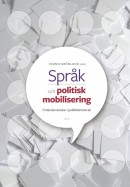 Språk och politisk mobilisering. Finlandssvenskar i publikdemokrati
Språk och politisk mobilisering. Finlandssvenskar i publikdemokrati
[Language and political mobilisation. Finland-Swedes in public democracy]
Red. [in Swedish; ed. by] Kimmo Grönlund
Helsingfors: Svenska litteratursällskapet i Finland (The Society of Swedish Literature in Finland), 2011. 236 p.
ISBN 978-951-583-224-5
€ 29, paperback
Under the Finnish Constitution, Finnish and Swedish are the country’s national languages. The status of Swedish is currently the subject of debate: on the one hand there is concern about the adequacy of Swedish-language services, while on the other there is a strong opposition among the Finnish-speaking majority to the mandatory study of Swedish. This book discusses, for example, the basis on which Finland’s 5.5 per cent Swedish-speaking minority elects its party and its candidates in national elections, and the importance of the Swedish language in this choice. Research suggests that Svenska Folkpartiet, the Swedish People’s Party, would gain increased backing if it were to emphasise the language question and seeking support for Swedish-speaking districts, rather than by targeting Finnish-speakers and bilingual citizens with an interest in minority issues. The book also contains a summary of the results of the Svensk politik i Finland (Politics in Swedish-speaking Finland) research project; Kimmo Grönlund – also director of research at Åbo Akademi – was head of the project.
Translated by David McDuff
New from the archives
29 January 2015 | This 'n' that
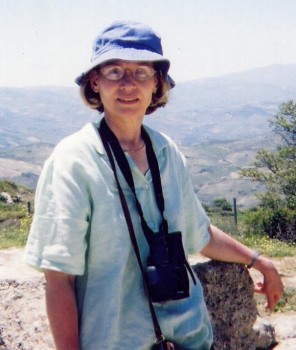
Ulla-Lena Lundberg
Low-lying, sea-girt pieces of rock strewn across the sea midway between Finland and Sweden, the Åland Islands – known in Finnish as Ahvenanmaa – are a world unto themselves. In mind and spirit they are separate from both Finland (to which they technically belong) and Sweden, giving their inhabitants, writers included, a fascinating outsider status.
This week’s archive find, an extract from Leo, the first volume of Ulla-Lena Lundberg’s trilogy set in 19th-century Åland, offers a compelling portrait of the potent mix of cosmopolitanism and (literal) isolation of the islands’ seafaring community, in which the men sail the seas and the women stay at home.
Born on Åland in 1947, Lundberg is a writer of novels, short stories, poems and other essays; her work, she says, derives from her habit of sitting under the table as a small child and listening to what the grown-ups said. She received the Finlandia Prize in 2012 for her novel Is [‘Ice’], and the Tollander Prize in 2011.
*
The digitisation of Books from Finland continues apace, with a total of 354 articles and book extracts made available online so far. Each week, we bring a newly digitised text to your attention.
Pertti Lassila: Metsän autuus. Luonto suomalaisessa kirjallisuudessa 1700–1950 [Bliss of the forest. Nature in Finnish literature 1700–1950]
21 December 2012 | Mini reviews, Reviews
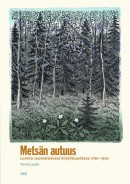 Metsän autuus. Luonto suomalaisessa kirjallisuudessa 1700–1950
Metsän autuus. Luonto suomalaisessa kirjallisuudessa 1700–1950
[Bliss of the forest. Nature in Finnish literature 1700–1950]
Helsinki: Suomalaisen Kirjallisuuden Seura (The Finnish Literature Society), 2011, 260 p.
ISBN 978-952-222-322-7
€35, paperback
Culture and art are relatively recent phenomena in Finland, but the forests, lakes and swamps have been here forever: national introspection has therefore always revolved around different ways of interpreting nature. National poet J.L. Runeberg (died 1877) romanticised the wilderness of the north and its starving inhabitants; pragmatic national philosopher J.V. Snellman (died 1881) rejoiced in the advances of continental culture in the farming regions of southwest Finland. Attempts to combine these two stances characterised the building of political and cultural ideas. Literary researcher Pertti Lassila follows the theme of nature through Finnish- and Swedish-language literature, including almost all major works up until the 20th century and some of the most important ones from the last century. His book is, at the same time, a description of the flow of ideas from the centre to the periphery, from the French classicist Carl Philip Creutz, author of hedonistic pastoral poetry, to Joel Lehtonen, writer of modern epics, whose endless pessimism was a largely constructed attempt to shape the split between nature and the alienated citizen of the 20th century; how successful he was is debatable. Nature remains a major theme in Finnish literature.
Translated by Claire Dickenson
Risto Uimonen: Juha Sipilä. Keskustajohtajan henkilökuva. [Juha Sipilä. Portrait of a centrist leader.]
23 June 2015 | Mini reviews, Reviews
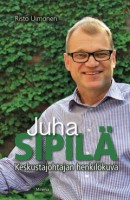 Risto Uimonen
Risto Uimonen
Juha Sipilä. Keskustajohtajan henkilökuva. [Juha Sipilä. Portrait of a centrist leader.]
Helsinki: Minerva, 2015. 431pp., ill.
ISBN 978-952-312-125-6
€33,90, hardback
Juha Sipilä was an information technology millionaire and business entrepreneur when, in 2011, he became, at his first attempt, a member of parliament for the Finnish Centre Party, which represents principally country people, is considered conservative in its values and had lost support. The very next year this engineer from northern Finland was elected chairman of the party. Through, among other things, numerous interviews, the experienced non-fiction writer and journalist Risto Uimonen builds a nuanced portrait of a party leader with a strongly ethical value-system that lies on his Christian faith. Characteristic of Sipilä are informality, consideration of others, practicality and the ability to present issues clearly and pithily. In his party, he has focused on issues that are important to him, such as the promotion of biotechnology. Uimonen offers a fluent portrait of the background to Sipilä’s life and surprising career development, to which, as the book was being completed, a family tragedy brought darker tones. After the publication of the book, Sipilä led the Centre Party to victory in the parliamentary elections of April 2015. As chairman of the biggest party, he began to form a government and has already been praised for his efficiency.
Love is the only song
7 August 2014 | Fiction, poetry
Poems from Helise, taivas! Valitut runot (‘Ring out, sky! Selected poems’, Siltala, 2014). Introduction by Marja-Leena Mikkola
Who will tell me?
Who will tell me why white butterflies
strew the velvet skin of the night?
Who will tell me?
While people walk, mute and strange
and they have snowy, armoured faces,
such snowy faces!
and the eyes of a stuffed bird.
Who will tell me why in the morning, on the grass,
the thrushes begin their secret game?
Who will tell me?
While black soldiers stand at the gate
in their hands withered roses
such withered roses!
and broken tiger lilies.
Who will tell me, quietly in the sun’s shadow
how to bare my heart?
Who will tell me?
Come to me over the fields
Come close and softly
so softly!
Open the clothes of my heart. More…
Finland(ia) of the present day
2 December 2010 | In the news
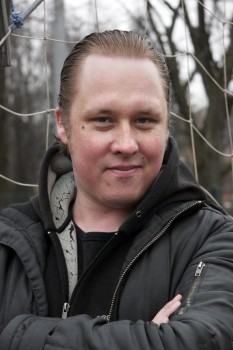
Mikko Rimminen. Photo: Heini Lehväslaiho
The Finlandia Prize for Fiction 2010, worth €30,000, was awarded on 2 December to Mikko Rimminen (born 1975) ; his novel Nenäpäivä (‘Nose day’, Teos) was selected by the cultural journalist and editor Minna Joenniemi from a shortlist of six.
Appointed by the Finnish Book Foundation, the prize jury (Marianne Bargum, former publishing director of Söderströms, researcher and writer Lari Kotilainen and communications consultant Kirsi Piha) shortlisted the following novels:
Joel Haahtela: Katoamispiste (‘Vanishing point’, Otava), Markus Nummi: Karkkipäivä (‘Candy day’, Otava), Riikka Pulkkinen: Totta (‘True’, Teos), Mikko Rimminen: Nenäpäivä (‘Nose day’, Teos), Alexandra Salmela: 27 eli kuolema tekee taiteilijan (’27 or death makes an artist’, Teos) and Erik Wahlström: Flugtämjaren (in Finnish translation, Kärpäsenkesyttäjä, ‘The fly tamer’, Schildts). Here’s the FILI – Finnish Literature Exchange link to the jury’s comments.
Joenniemi noted the shortlisted books all involve problems experienced by people of different ages. How to be a consenting adult? How do adults listen to children? Contemporary society has been pushing the age limits of ‘youth’ upwards so that, for example, what used to be known as middle age now feels quite young. And, for example, in Erik Wahlström’s Flugtämjaren (now also on the shortlist for the Nordic Literature Prize 2011) the aged, paralysed 19th-century author J.L. Runeberg appears full of hatred: being revered as Finland’s national poet didn’t make him particularly noble-minded.
According to Joenniemi, Rimminen’s novel ‘takes a stand gently’ in its portrayal of contemporary life – in a city where a lonely person’s longing for human contacts takes on tragicomical proportions. Joenniemi finds Rimminen’s language ‘uniquely overflowing’. Its humour poses itself against the prevailing negative attitude, turning black into something lighter.
Rimminen has earlier published two collections of poems and two novels (Pussikaljaromaani, ‘Sixpack novel’, 2004, and Pölkky, ‘The log’, 2007) . Pussikaljaromaani has been translated into Dutch, German, Latvian, Russian and Swedish.
Solzhenitsyn and Silberfeldt: Sofi Oksanen publishes a best-seller
25 April 2012 | In the news
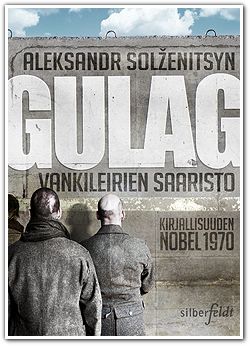
Nobel Prize 1970: Aleksandr Solzhenitsyn
After falling out with her original publisher, WSOY, in 2010, author Sofi Oksanen – whose third novel, Puhdistus (Purge, 2008), has become an international best-seller – has founded a new publishing company, Silberfeldt, in 2011, with the aim of publishing paperback editions of her own books. Its first release was a paperback version of Oksanen’s second novel, Baby Jane.
Oksanen’s new novel, Kun kyyhkyset katosivat (‘When the pigeons disappeared’), again set in Estonia, will appear this autumn, published by Like (a company owned by Finnish publishing giant Otava).
However, in April Silberfeldt published a new, one-volume edition of the autobiographical novel The Gulag Archipelago by the Nobel Prize-winning author Alexandr Solzhenitsyn. This massive book was first published in the West in 1973, in the Soviet Union in 1989.
A Finnish translation was published between 1974 and 1978. Back in those days of Cold War self-censorship, Finnish publishers felt unable to take up the controversial book, and the first volume was eventually printed in Sweden. The work, finally published in three volumes, has long since been unavailable.
This time the 3,000 new copies of Solzhenitsyn’s tome sold out in a few days; a second printing is coming up soon. Oksanen regards the work as a classic that should be available to Finnish readers.
Jouko Halmekoski: Orjamarkkinat. Huutolaislasten kohtaloita Suomessa [The slave market. The fate of auctioned pauper children in Finland]
17 November 2011 | Mini reviews, Reviews
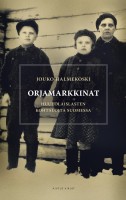 Orjamarkkinat. Huutolaislasten kohtaloita Suomessa
Orjamarkkinat. Huutolaislasten kohtaloita Suomessa
[The slave market. The fate of auctioned pauper children in Finland]
Helsinki: Ajatus Kirjat, Helsinki, 2011. 225 p., ill.
ISBN 978-951-20-8391-6
€ 26, hardback
Auctions of people were at their most widespread in Finland in the 1870s and 1880s; ‘auctioned paupers’ were entrusted for a year at a time to the one who put in the lowest bid for the pauper’s upkeep, then recompensed by the local authority. The people who were auctioned off included children, the elderly, disabled and mentally ill people. These auctions were banned in 1923, but they continued for some time thereafter. Although the practice was widely known about, the paupers’ shame prevented much discussion of the subject. Those who wished to provide help to people in need were probably greatly outnumbered by those who sought to benefit from their plight. In most cases, orphaned children ended up being auctioned off. Children born out of wedlock were another significant group. Jouko Halmekoski advertised in the newspapers in order to trace the lives and descendants of those who were auctioned off. Not all the auctioned paupers’ histories are tales of horror: this book, consisting of 25 of them, also includes stories of children who were treated well.
Translated by Ruth Urbom
Jaakko Blomberg: Vakauden kaipuu. Kylmän sodan loppu ja Suomi [Longing for stability. Finland and the end of the Cold War]
2 November 2011 | Mini reviews, Reviews
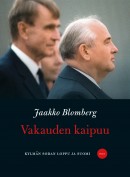 Vakauden kaipuu. Kylmän sodan loppu ja Suomi
Vakauden kaipuu. Kylmän sodan loppu ja Suomi
[Longing for stability. Finland and the end of the Cold War]
Helsinki: WSOY, 2011. 696 p., ill.
ISBN 978-951-0-37808-3
€ 37, hardback
From Finland’s perspective, the termination of the Cold War era encompassed three significant processes: the Soviet Union’s policy of perestroika, or reform, and the disintegration of its empire; the end of the international arms race and the rise of joint security as a policy aim of the superpowers; and increasing European integration. This book devotes individual chapters to two phases of Finnish foreign policy – interpretation of the Paris Peace Treaty and Finland’s withdrawal from the Agreement of Friendship, Cooperation and Mutual Assistance, which it had signed with the Soviet Union in 1948. The second part of the book focuses on the years 1992–94, when Finland applied to become a member of the European Union and forged relations with the new Russia. Finland’s position in those years was defined by Mauno Koivisto, a cautious president, whose memoirs have served as a key source of material for Blomberg. The negotiations surrounding the region of Karelia, which was ceded to the Soviet Union after the war, are illuminated further here. As a Finnish ambassador, Blomberg served in key roles within the Ministry for Foreign Affairs from the late 1980s to the early 21st century.
Translated by Ruth Urbom
Panu Rajala: Naisten mies ja aatteiden. Juhani Ahon elämäntaide [A ladies’ man of ideas. Juhani Aho’s art of living]
26 January 2012 | Mini reviews, Reviews
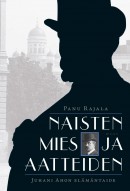 Naisten mies ja aatteiden. Juhani Ahon elämäntaide
Naisten mies ja aatteiden. Juhani Ahon elämäntaide
[A ladies’ man of ideas. Juhani Aho’s art of living]
Helsinki: WSOY, 2011. 441 p., ill.
ISBN 9789510374412
€ 35, hardback
Of Juhani Aho (1861–1921) it is said that he created what have proved to be the most enduring descriptions of how traditional Finland began to be modernised; his most famous book is the novella Rautatie (‘The railway’, 1884) which portrays the arrival of the railway in the Finnish countryside. This new biography also shows once again how many international influences can be found in the work of Aho, who is often called a national author. Aho was active in student politics, and as a newspaper journalist. He was nominated for the Nobel Literature Prize twelve times, but for various reasons, some of them connected with language politics, lobbying on his behalf was not successful. Aho developed Finnish prose, bringing to it realism and impressionistic style. His experiences during a visit to Paris in 1889 form the basis of his novel Yksin (‘Alone’), which caused a stir in part because of its erotic flavour. This book by the author and literary scholar Panu Rajala provides a versatile insight into Aho’s personal story, the world of his ideas, his opinions on art, and his complex relationships.
Translated by David McDuff
Jussi T. Lappalainen: Kuninkaan viimeinen kortti [The king’s last card]
28 October 2011 | Mini reviews, Reviews
 Kuninkaan viimeinen kortti. Viipurinlahden ja Ruotsinsalmen meritaistelut 1790
Kuninkaan viimeinen kortti. Viipurinlahden ja Ruotsinsalmen meritaistelut 1790
[The king’s last card. The naval battles of Viipurinlahti and Ruotsinsalmi 1790]
Helsinki: Suomalaisen Kirjallisuuden Seura, 2011. 214 p., ill.
ISBN 978-952-222-230-5
€ 44, hardback
The War of Gustav III (1788–1790) was a conflict between Sweden and Russia whose aim was to regain the Baltic lands and the eastern areas of Finland for Sweden. The war plan was based on a manoeuvre strategy considered ideal from the end of the15th century in which the aim was to achieve the desired outcome by deploying one’s own forces in such a way that the enemy was forced to surrender without fighting. A substantial part of the Swedish forces were made up of an impressive navy which was nevertheless surrounded by the Russians. The king’s trump card was his archipelago fleet, which managed to defeat the Russians completely on 9 July 1790. The battle of Ruotsinsalmi was, in terms of the number of vessels involved, one of the largest naval battles ever waged. Its anniversary is celebrated as the anniversary of the Finnish naval forces. The book traces the background of the reasons for the outbreak of the war and its consequences and describes the vessels weaponry and tactics. Included are numerous contemporary maps and battle paintings. Translated by Hildi Hawkins
Make or break?
17 November 2011 | This 'n' that
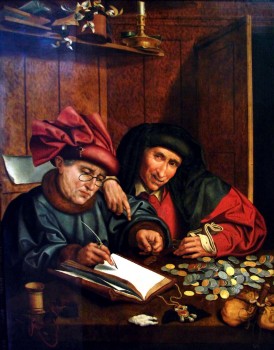
Two tax collectors: anonymous painter, after Marinus van Reymerswaele (ca. 1575–1600). Musée des Beaux-Arts de Nancy. Wikimedia
In Finland, tax returns are public information. So, every November the media publish lists of the top earners in Finland, dividing them into the categories of earned and investment income. Every November it is revealed who are millionaires and who are just plain rich.
The Taloussanomat (‘The economic news’) newspaper offers a list (Finnish only) of the 5,000 people who earned most last year (in terms of both earned and investment income, together with the proportion of income they have paid in tax). You can also search lists of various status and professions: rock/pop stars, media, sports, MPs, celebrities, politicians of various political parties…
So let’s take a look at Taloussanomat’s selected list of authors: number one is the celebrity author Jari Tervo (309,971 euros, tax percentage 45); number two, the internationally famous Sofi Oksanen (302,634 euros, 46 per cent); the next two are Sinikka Nopola, writer of children’s books, (264,000) and Arto Paasilinna (262,300; now after an illness, retired as a writer), translated into more than 30 languages since the 1970s. (The film critic and author Peter von Bagh made almost 900,000 euros – not by writing books, but by selling his share of a music company to an international enterprise.)
As tax data are public in Finland, there’s vigorous and decidedly informed public debate on how much money, for example, directors of public pension institutions and government offices or ministers and other top politicians are paid, and how much they should be paid: what is equitable, what is reasonable? A million dollar question indeed…
Among the European Union countries, it is only in Finland, Sweden and Denmark that there is no universal minimum wage. Here, wages are determined in trade wage negotiations. The average monthly salary in the private sector in 2010 was approximately 3,200 euros. In contrast to that, Olli-Pekka Kallasvuo, the Nokia CEO and President, who tops the 2010 tax list, earned a salary of 8 million last year, because – and precisely because – he was sacked (and replaced by the Irishman Steven Elop).
The CIA’s Gini index measures the degree of inequality in the distribution of family income in a country. The more unequal a country’s income distribution, the higher is its Gini index. The country with the highest number is Sweden, 23; the lowest, South Africa, 65 (data from both, 2005). Finland’s figure is 26.8 (2008), Germany 27 (2006), the European Union’s 34. The United Kingdom stands at 34 (2005), and the USA at 45 (2007). The figure in Finland seems to be on the rise though, as the figure back in 1991 was 25.6.
There’s been plenty of research and debate on economic inequality and the ways it harms societies. This link takes you to a fascinating video lecture (July 2011 – now seen by almost half a million people) by Richard Wilkinson, British author, Profefssor Emeritus of social epidemiology.

